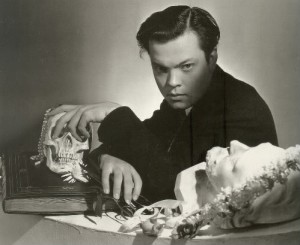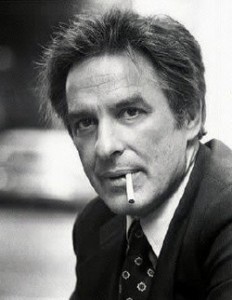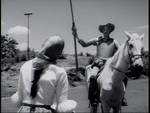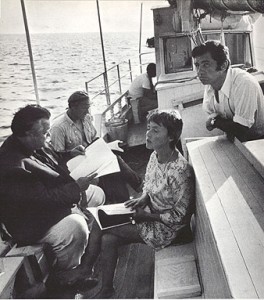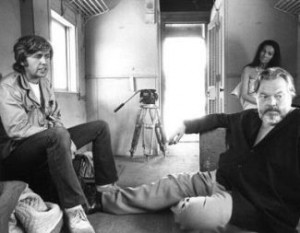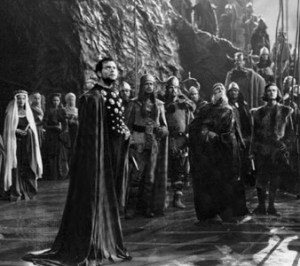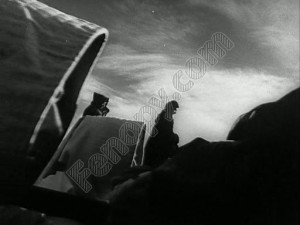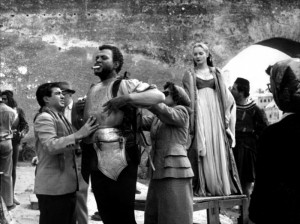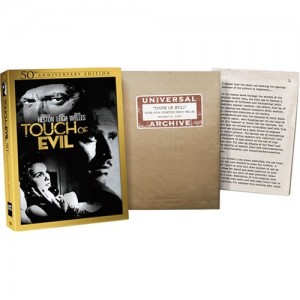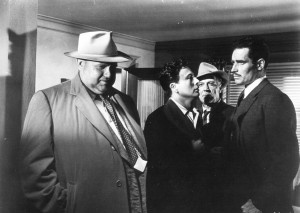Originally written as the tenth chapter of my book Movie Wars: How Hollywood and the Media Limit What Films We Can See (2000), this is also reprinted in my 2007 collection Discovering Orson Welles. Because of the length of this essay, I’m posting it in two installments – J.R.
3. The taboo against financing one’s own work. I assume it’s deemed
acceptable for a low-budget experimental filmmaker to bankroll his or
her own work, but for a “commercial” director to do so is anathema
within the film industry, and Welles was never fully trusted or respected
by that industry for doing so from the mid-forties on. This pattern
started even before Othello, when he purchased the material he had
shot for It’s All True from RKO with the hopes of finishing the film
independently, a project he never succeeded in realizing. As an
overall principle, he did something similar in the thirties when he
acted in commercial radio in order to surreptitiously siphon money
into some of his otherwise government-financed theater productions
during the WPA period, a practice he discusses in This Is Orson
Welles. John Cassavetes, who also acted in commercial films in order
to pay for his own independent features, suffered similarly in terms of
overall commercial “credibility,” which helps to explain why he and
Welles admired each other. (In an early stage of his work on the
unrealized The Big Brass Ring, a late script and project, Welles
thought of casting Cassavetes and his wife Gena Rowlands as
presidential candidate Blake Pellarin, the hero, and his wife, Diana.)
In the case of features that were largely financed out of Welles’s own
pocket, such as Don Quixote and The Deep/Dead Reckoning,
Welles often insisted in interviews that when or if he finished and
released these features was nobody’s business but his own — an
attitude that often met with resentment and/or incomprehension
from his fans. This raises a good many intriguing and not easily
resolvable questions about the implied social contract that exists
between artist and audience, and one that is undoubtedly inflected
by the relative power of the industry to deliver films to theaters and
the relative powerlessness of most film artists to ensure that their
own films get distributed.
In Welles’s case, the poor critical receptions and poor business that
greeted most of his releases, at least in the United States, made him
understandably hesitant to risk whatever remained of his “bankability”
by releasing any of his films prematurely, or at the wrong time; he was
also handicapped throughout his career by being a terrible business-
man and often made wrong guesses about the commercial viability of
some of his projects. I’m told that he once turned down a relatively
generous offer from Joseph Levine to distribute F for Fake in the United
States, an offer Levine made even though he had nodded off during a
screening; convinced that his film would be a big moneymaker, Welles
turned him down flat, only to accept a less lucrative offer years later in
order to get any American distribution at all.
When I asked him about Don Quixote in the early seventies, he replied
that Man of La Mancha was currently being developed as a movie and
he didn’t want his own version to compete with it. This statement
astonished me at the time, but after I reflected on all the abuse he
received from the American press about the inferiority of his Macbeth
to Laurence Olivier’s Hamlet, I began to think his fears might have
been justified. (When I asked him about The Deep, he insisted that it
was the sort of melodrama that wouldn’t date, and that he was more
interested in releasing The Other Side of the Wind first — although
this eventually proved to be impossible for legal and financial reasons
that are documented in Barbara Leaming’s Welles biography.)
4. The unique forms of significant works. It surely isn’t accidental
that we have only one completed version of Citizen Kane to evaluate.
By contrast, we have at least two completed versions of Welles’s
Macbeth, three versions of his Othello, and at least four versions
apiece of his Mr. Arkadin and Touch of Evil, to provide only a
short list. (There’s also, for example, a separate version of The Lady
from Shanghai that has circulated in Germany containing some
takes as well as shots that are different from those in the U.S. release
version.)
The reasons for this confusing bounty are multiple, but all of them
ultimately stem from Welles’s unorthodox practices as a filmmaker.
When early audiences and critics complained about the Scottish
accents and the length of the first version of Macbeth (which is
incidentally the one principally available today), Welles obligingly
had the film redubbed and deleted two reels’ worth of material.
(Most critics assume mistakenly that the only Hollywood film on
which he had final cut was Kane; in fact, he also had final cut on
both versions of Macbeth, even if the second version was done at
the behest of Republic Pictures.)
Othello, on the other hand — Welles’s first completed independent
feature — was partially reedited and redubbed at Welles’s own initiative,
between the time of its Cannes premiere and its belated U.S. release
over three years later. Although you won’t find this information in any
of the “authoritative” books about Welles, French film scholar
François Thomas has recently discovered that Welles redubbed
Desdemona — played in the film by Suzanne Clothier, who shot her
sequences in 1949 and 1950 — with the voice of Gudrun Ure (later
known as Ann Gaudrun), the actress who played Desdemona in his
subsequent 1951 English stage production of the play, entailing a
different interpretation of the same part. Over forty years later, long
after Welles’s death, the sound track of this second version was
significantly altered — both sound effects and music were rerecorded
in stereo, in the latter case without consulting composer Francesco
Lavignino’s written score, and the speed of the dialogue delivery was
occasionally altered to improve the lip sync — in order to release the
results as a so-called “restoration.”(8)
____________________________________________
[8] In the cases of both Mr. Arkadin and Touch of Evil, Welles never had final cut on any version, so all of the existing versions represent different attempts to realize his intentions after the film slipped out of his control. (Arkadin was taken away from him at a relatively early stage in the editing, Touch of Evil at a relatively late stage.) For a more detailed critique of the third version of Othello — the only one readily available in the United States thanks to the pressures of Welles’s youngest daughter, Beatrice, who maintains legal control of this film — see “Othello Goes Hollywood” in my collection Placing Movies: The Practice of Film Criticism (Berkeley: University of California Press, 1995, pp. 124–132) and Michael Anderegg’s excellent Orson Welles, Shakespeare, and Popular Culture (New York: Columbia University Press, 1999, pp. 111–120).
Though it’s theoretically possible to assign different evaluations to
the separate versions of Macbeth and Othello, critics have rarely
bothered to carry out this work; in fact, most of them have been
unaware that these separate versions exist. The fact that both
versions of Macbeth and the first two versions of Othello were
all Welles’s own handiwork means that we can’t rank them in terms
of authenticity (except to note that the second Macbeth wasn’t
instigated by him). We can’t, for instance, argue that the
European Othello is “more Wellesian” or “truer to Welles’s
intentions” than the initial U.S. version, and consequently it
becomes impossible to speak of a “definitive” film version of
Welles’s Othello.
The same principle was carried out more publicly by Jean-Marie
Straub and Danièle Huillet — a European couple who make rigorous
and beautiful avant-garde films that, in recent years, have rarely been
screened in the United States — when they deliberately released four
separate versions of their 1986 feature The Death of Empedocles,
each employing separate takes of each shot, to correspond to the
separate languages of each version: unsubtitled German, English
subtitles, French subtitles, and Italian subtitles. Straub argued that
this was done in order to challenge the notion of uniqueness that we
habitually assign to individual films, and he certainly had a point,
but Welles made the same point more offhandedly and surreptitiously
three decades earlier when he refashioned his second Othello without
bothering to announce that he was doing so.
Why, one may ask, did Welles do this? Because he loved to work,
one might surmise, and because for him all work was work-in-
progress — both reasons helping to explain why he often wound up
having to finance much of the work himself. To love the process of
work to this degree evidently offends certain aspects of the Protestant
work ethic. Judging from the jibes about Welles’s obesity in his later
years that often cropped up in his American obituaries — but not in
most obituaries that appeared elsewhere in the world — Welles’s
reputation as a hedonist was often used against him to imply
irrationally that all his production money went to pay for expensive
meals; indeed, many people preferred to believe that the only reason
he didn’t make or finish or release more films was out of laziness and
moral turpitude. (This is more or less the thesis of biographers Charles
Higham, David Thomson, and, to a lesser extent, Simon Callow, none
of whom ever met the man.)
Obviously the fact that Welles loved to make films — and often sacrificed
his reputation as an actor by appearing in lots of TV commercials and
bad movies in order to keep doing so — doesn’t square with this
hypothesis, except to imply that to some degree he wound up
tarni0shing part of his public profile in order to subsidize his art. The
process by which a public figure became a private artist is obviously
fraught with contradictions, but one should never forget that it was
love of the art-making process itself that ultimately sabotaged
Welles’s commercial profile. And as the Chilean-French filmmaker
and devoted Welles fan Râùl Ruiz once said to me, in defense of
Welles’s reputation as a maker of unfinished films, “All films are
unfinished —except, possibly, those of Bresson.” Which leads us
logically to
5. Incompletion as an aesthetic factor. Critics confronting Franz
Kafka’s three novels have less of a problem with this — at least Kafka is
rarely castigated as an artist to the degree that Welles is. Could this be
because money is involved more centrally with making movies than
with writing novels? It’s also important to recognize that no two of
Welles’s unfinished films remain unfinished for the same reason. This
is the portion of Welles’s oeuvre that’s most notoriously difficult to
research, but on the basis of what I’ve been able to glean over the years,
Welles wanted and made repeated efforts to finish both It’s All True
and The Other Side of the Wind, came close to finishing Don
Quixote in at least one version in the late fifties (according to former
Welles secretary Audrey Stainton; see her article, “Don Quixote: Orson
Welles’s Secret” in the Autumn 1988 Sight and Sound), and eventually
abandoned The Deep for personal as well as commercial reasons.(9)
[9] One film commonly described as unfinished — Welles’s forty-minute condensation of The Merchant of Venice, his only Shakespeare film in color, designed in the late sixties to serve as the climax to a CBS TV special — was in fact fully edited, scored, and mixed, though most of it was spirited away by an Italian editor after a single private screening; one hopes that eventually the full version will see the light of day. Nine minutes of this film are currently held by the Munich Film Archive. Two other completed short films — Camille, the Naked Lady, and the Musketeers (1956) and Viva l’Italia! (aka Portrait of Gina, circa 1958) — are unsold, half-hour TV pilots; the first of these is lost, though the second resurfaced three decades later, and was recently shown in its entirety on German TV. Needless to say, the list goes on. . . .
So much for incomplete works — which doesn’t, of course, include
features wrestled away from Welles’s control and completed by others,
such as The Magnificent Ambersons and Mr. Arkadin. But what
about the incompleteness of Welles’s oeuvre as a whole, an even more
serious problem due to the unavailabilty of so many of his works,
finished and unfinished alike? Some of these, like the films he made as
integral parts of stage versions in the thirties or the portions of features
(The Magnificent Ambersons, The Stranger, The Lady from
Shanghai) deleted by studios, are almost certainly lost for good. Some
films, such as his first and best TV pilot (The Fountain of Youth,
1956) and Filming “Othello” (1979), remain unavailable simply
because of “business reasons” (i.e., the indifference of the copyright
holder or legal obstacles, which often amount to the same thing),
with the result that most American viewers are scarcely aware of
their existence. Three extended TV series made by Welles in Europe
— Orson Welles Sketch Book (six 15-minute episodes, 1955),
Around the World with Orson Welles (five completed half-hour
episodes and one unfinished episode, 1955), and In the Land of
Don Quixote (nine half-hour episodes, 1964) — survive but remain
unavailable in the United States. [2014 postscript: The second of these
is now available on DVD.] And most of the unfinished work has wound
up in film archives—the Fortaleza footage of It’s All True at UCLA
(although the footage that survives from that feature continues to be
in peril until funds are found to preserve it), Don Quixote and In the
Land of Don Quixote at the Filmoteca Española in Madrid,
and, most recently, a varied collection of unfinished work (including
The Deep, Orson’s Bag, The Magic Show, and The Dreamers)
at the Munich Film Archive, which is still seeking ways of restoring and
presenting it.
Without implying that all this material is equally important or interesting
— I regard most of In the Land of Don Quixote as amiable hackwork
at best — I would argue that a significant part of it, judging from the
portions that I’ve seen or sampled, substantially alters one’s sense of
Welles’s oeuvre as a whole, extending its range and diversity while
illuminating certain work that one already knows. This ultimately
means that, fifteen years after his death, we are still years away from
being able to grasp the breadth of Welles’s film work, much less
evaluate it.
6. A confounding of the notion of art as commodity. We’re finally left
with the problem of how to evaluate Welles’s still-ungraspable
oeuvre in relation to the international film market — an issue that is
currently preoccupying a good many film executives as well as
archivists considering the possibility of completing and/or
releasing films by Welles that haven’t yet been seen. Prior to the
very successful commercial release of the reconfigured Touch
of Evil, the prospects of getting any of these films out on the
world market was beginning to look rather dim. (To date,
Jesus Franco’s lamentable version of Welles’s Don Quixote
— hastily edited in order to premiere in a Spanish-language
version at Spain’s Expo 92, and subsequently completed in an
English-language version as well — has failed to find a
U.S. distributor; to the best of my knowledge, it has only
received a few scattered screenings in North America,
most notably at New York’s Museum of Modern Art.)
Now that the commercial prospects are looking
somewhat more favorable, numerous questions
still remain — including how these “new” (or “old”)
works are to be represented.
“Welles’s Lost Masterpiece” was the phrase used in ads for the
significantly altered version of Welles’s 1952 Othello released
in 1992 — although the film had never been lost at all; it had
simply been out of distribution in the United States for many
years. The new version, moreover, was billed as a “restoration,”
and this was how it was labeled by a good ninety-five-percent
of the reviews in the press; in The New York Times, for
instance, Vincent Canby called it “an expertly restored print that
should help to rewrite cinema history.” But as Michael Anderegg
has pointed out,
To term the project authorized by Beatrice Welles-Smith as a ‘restoration’ is to make nonsense of the word. One cannot restore something by altering it in such a way that its final state is something new. To restore means, if it means anything, to bring back to some originary point — itself, of course, an extremely dubious concept. . . .
If you find a Greek statue with a left arm missing, you might be able to restore it if, (a) you can demonstrate, through internal and external evidence, that it once had a left arm and (b) you can discover some evidence of what the left arm looked like when it was still attached. If, however, the statue was meant to have no left arm (a statue, perhaps, of a one-armed man), or if the statue was never completed by the sculptor, or if, assuming the arm did once exist and had broken off, you have no evidence of what the missing arm had originally looked like, then adding an arm of your own design is not an act of restoration. You are, instead, making something new.(10)
___________________________________________
[10] Orson Welles, Shakespeare, and Popular Culture, op. cit., p. 112.
According to Anderegg’s subsequent analysis, the version of Welles’s
Othello described as a “restoration” alters not only Welles’s original
sound design and Francesco Lavignino’s score, but also reloops some of
the dialogue with new actors, eliminates some words “so that a lip-synch
could be achieved,” and reedits one sequence entirely. But of course the
use of the term “restoration” in relation to movies has become so loose
and imprecise in recent years that it characteristically gets employed
every time a studio decides to strike a new print, add footage without
consulting the original director, or, on a few rare occasions, rework an
old movie with the original director’s input (as in the rereleased
Blade Runner, which proved to be partly a restoration of Ridley
Scott’s original cut and partly a revision — including the insertion of a
shot of a unicorn taken from Scott’s Legend, a film made three years
after Blade Runner). Typically, the summer before Universal Pictures
released the reedited version of Touch of Evil, it reissued on video the
preview version of the film that had already been available since the
seventies and mislabeled it not only a “restoration” but the “director’s
cut,” which was even more ridiculous — adding insult to injury insofar
as Universal had never allowed Welles to complete a final cut of his own
in the first place, which in fact is what occasioned his fifty-eight-page
memo to Universal studio head Edward Muhl.
Significantly, in the early nineties, when I originally tried to get an
American film magazine interested in publishing roughly two-thirds
of this memo, a document drafted in 1957, Premiere and Film
Comment both turned me down flat; if memory serves, the former
considered the document far too esoteric and the editor of the latter,
who wasn’t even interested in reading the text, felt that Film
Comment had lately been concentrating too much on Welles.(11)
______________________________________
| [11] More recently, Film Comment reviewed two dubious Welles-related films, Cradle Will Rock and RKO 281, but refused to consider running any reports on restorations of unseen Welles films in Munich. |
For me, the document was fascinating and revealing because it delved
so deeply into Welles’s artistic motivations — something that he was
rarely willing to comment about elsewhere, even in his book-length
interview with Peter Bogdanovich — but this consideration cut no ice
with either magazine. Then, seven years later, as soon as Universal
Pictures had a version of Touch of Evil based on following the
instructions of the memo, the same text suddenly became a hot item,
and Premiere even wound up commissioning me to write a short
article about the new version of the film. (The quarterly Grand Street
also expressed a strong interest in printing excerpts from the memo
until it discovered belatedly — not having grasped the fact earlier,
through a misunderstanding — that excerpts were about to appear in
the second edition of This Is Orson Welles.) The difference in attitudes
was clear: in the early nineties, the text had no “currency” because it
wasn’t tied to any currently marketable item; by the late nineties, it had
suddenly taken on a promotional value in relation to one of Universal’s
upcoming releases.
For more or less the same reason, a lengthy production report in
the Los Angeles Times in 1998 on the upcoming release of George
Hickenlooper’s The Big Brass Ring, based on a much-revised version
of Welles’s 1982 script that had been revamped by film critic F. X.
Feeney and Hickenlooper, went out of its way to disparage Welles’s
original script as something that needed to be updated and reworked
in order to be relevant to a 1999 audience. The reporter gave no
indication of having read the Welles script in order to test this premise;
the article was content to quote actor Nigel Hawthorne reading aloud
from David Thomson’s attack on the script in Rosebud in order to
demonstrate that Welles’s work clearly needed a polish. However
ludicrous this assumption seemed to me at the time, I also realized it
was typical of entertainment journalism. The fact that Hickenlooper’s
movie was shortly to become an item on the marketplace — while the
limited edition of Welles’s screenplay, which had sold out its print run
of one thousand copies shortly after its publication in 1987, was no
longer an item on the marketplace — was the only thing that mattered,
and pre-emptive comparative evaluations of the two were relevant only
insofar as they helped to promote the Hickenlooper feature. (In fact,
Hickenlooper’s film revised the original script so extensively that few
traces of the original remained.)
***
The half-dozen forms of ideological challenge discussed above are by
no means exhaustive when it comes to outlining the continuing
provocation and interest of Welles’s work. But I hope they adequately
suggest the degree to which his work and the various problems it raises
throw into relief many of the issues I’ve been discussing throughout
this book. For generations to come, I suspect, Welles will remain the
great example of the talented filmmaker whose work and practices
deconstruct what academics, taking a cue from the late French theorist
Christian Metz, are fond of calling “the cinematic apparatus.” This is not
necessarily because he wanted to carry out this particular project, but
more precisely because his sense of being an artist as well as an
entertainer was frequently tied to throwing monkey wrenches into our
expectations — something that the best art and entertainment often do.

